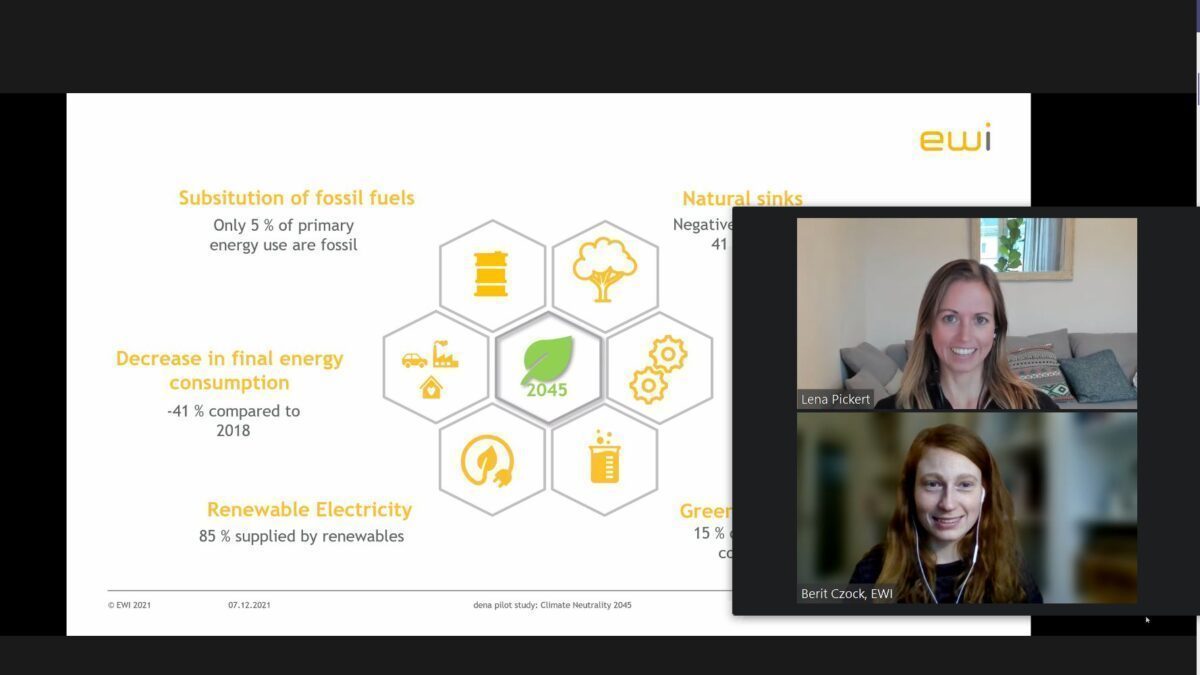
“The decarbonization of power generation is an important step towards climate neutrality. Our analysis shows that this requires a comprehensive transformation of the power plant fleet even beyond the planned coal and nuclear phase-out,” says EWI researcher Berit Hanna Czock.
Together with her colleague Lena Pickert, Berit Hanna Czock presented details from the expert report of the Institute of Energy Economics at the University of Cologne (EWI) in the context of the “dena-Leitstudie Aufbruch Klimaneutralität” (dena pilot Study Climate Neutrality 2045). At the digital event EWI Insights on December 7, the two researchers talked about transforming the building, industry, and transport sectors and the energy system.
“The transformation of the end-use sectors industry, transport, and buildings is a particular challenge: Climate protection ambitions in all sectors must be significantly accelerated to achieve the sectoral targets in 2030 and the declared goal of climate neutrality in 2045,” Lena Pickert explains. In addition to increasing energy efficiency and using innovative technologies, consumer and mobility behavior changes also play an essential role.
In the industry sector, fossil fuels such as natural gas or coal are currently commonly used. In the EWI expert report scenario, these energy sources are primarily substituted by electricity and hydrogen. Lena Pickert explains: “To this end, the study assumes switches to innovative process technologies and increases in energy efficiency as well as changes in production volumes and higher recycling rates” .
Lena Pickert adds: “In the transport sector, an interplay of technological and transformational approaches is necessary to reduce emissions accordingly”. Above all, electrification in passenger transport plays a decisive role. The share of electric vehicles increases significantly, and domestic flights and car traffic are partly shifted to more environmentally friendly buses and trains in the scenario. In the long term, hydrogen will be increasingly used for road freight transport, especially for long-distance routes.
Lena Pickert points out :”In the building sector, a comprehensive change of energy sources and heating systems, as well as an improvement of the building’s energy envelope, is necessary to achieve the targets”. In the study, the renovation rate increases significantly. Additionally, oil- and gas-based heating systems are gradually phased out while heat pumps, biomass heating systems, and district heating are gaining importance. Further, newly installed gas heating systems are assumed to be hydrogen-ready from 2024. Thus, hydrogen also plays a role in heat generation in the long term.
Overall, final energy demand declines by 41 percent by 2045 compared to 2018 according to the EWI’s projections. Electricity would then become the most important final energy source. In the EWI scenario, hydrogen is mainly used when electricity is not an option for decarbonization. Hydrogen becomes the second most important final energy carrier.
With an increased demand for electricity from the end-use sectors come increased requirements for the power plant fleet to provide low-emission electricity. Green electricity is also the backbone for a national hydrogen economy that meets at least part of the demand by domestic production. Berit Czock highlights: “The installed capacity of renewable energies will be more than doubled by 2030 in the EWI scenario”. “Renewables will then reach a share of 68 percent in meeting gross electricity demand.”
At the same time, the coal phase-out is accelerated by market forces. The decline in coal-fired power plants will be partially compensated by installing gas-fired power plants: 15 GW will be added by 2030 compared to 2019. These power plants are designed to use flexible shares of hydrogen for electricity generation. Power generation from gas power plants initially increases significantly in the scenario; from 2035, gas-fired power plants increasingly take on a backup role as renewables continue to expand. In the scenario hydrogen is used for electricity generation from 2040 onwards. Due to the decline in conventional power generation, Germany could turn from a net electricity exporter into a net electricity importer from 2030 on.
“Carbon sinks play another important role. The remaining residual emissions – mainly from the industrial and agricultural sectors – are offset by technical and natural sinks in the scenario. “Forests and other natural sinks play a special role here,” Berit Czock explains. These are expected to remove 41 Mt of CO2 equivalents from the atmosphere in 2045. This means natural sinks can almost offset the residual emissions from the agricultural sector, which arise, e.g., from livestock and the use of fertilizers. To build up and maintain natural sink capacity, according to the findings of an analysis carried out by the Öko-Institut, forests and other natural sinks must be protected and converted to be climate change-resistant.